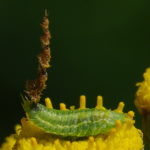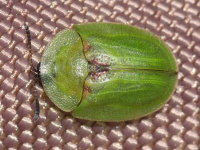Phylum Arthropoda (Arthropods) ➔ Subphylum Hexapoda (Hexapods) ➔ Class Insecta (Insects) ➔ Order Coleoptera (Beetles) ➔ Family Chrysomelidae (Leaf beetles)
Cassida (Cassida) stigmatica Suffrian, 1844
Rainfarn-Schildkäfer
Classification:
Cassida stigmatica belongs to the subfamily Cassidinae, tribe Cassidini.Distribution:
Europe (absent in the far north and on the British Isles), Tunisia, Turkey, east to Afghanistan.Habitat:
Tall forb communities, ruderal areas, roadsides - places, where Tanacetum vulgare is growing.Description:
Length 5.5 - 6 mm; underside black; pronotum narrower than the elytra, with rounded corners; elytra green (yellow when dead), often with 2 reddish spots on each side of the base, without black spots on the shoulder; base of the elytra rather deeply emarginated; lateral margin of the elytra bent and flattened, elytra with a flat longitudinal impression behind the middle between the 4th and 8th dot strip; elytra moderately coarsely dotted with ± irregular dot strips, at least in the 3rd and 4th interspace there are surplus dots; forehead broad, not more than 1/4 longer than broad, usually almost square; clypeus black; antennae and legs yellow.The larvae are green with a broad yellow-green central stripe and short side spines.
Biology:
The monophagous Cassida stigmatica lives on tansy (Tanacetum vulgare). The adult beetles appear in late April to early May, when the host plants have developed their first rosettes. After mating, the females lay their eggs on the undersides of the leaves of the host plant. The larvae of the species carry no feces shield, but only the stripped skins of the previous larval stages. Pupation takes place on the host plant. The new generation appears from late June to July.References, further reading, links:
- Rheinheimer, Joachim, & Hassler, Michael: Die Blattkäfer Baden-Württembergs, 2018, 928 pages, Kleinsteuber Books (Karlsruhe), ISBN 978-3-9818110-2-5
- Arved Lompe: Die Käfer Europas - Ein Bestimmungswerk im Internet
- Altica sp.
- Bruchus sp.
- Cassida nebulosa
- Cassida sp.
- Cassida stigmatica
- Cassida vibex
- Cassida vibex/bergeali
- Chrysolina lucidicollis
- Chrysolina oricalcia
- Chrysolina sp.
- Chrysolina sturmi
- Chrysolina varians
- Chrysomela tremula
- Coptocephala sp.
- Crepidodera aurea
- Crepidodera fulvicornis
- Cryptocephalus moraei
- Cryptocephalus nitidus
- Cryptocephalus pusillus
- Cryptocephalus sp.
- Donacia cinerea
- Donacia marginata
- Donacia versicolorea
- Galeruca tanaceti
- Galerucella s.l.
- Gonioctena decemnotata
- Gonioctena quinquepunctata
- Gonioctena sp.
- Gonioctena viminalis
- Lema cyanella
- Neocrepidodera sp.
- Oulema melanopus/duftschmidi
- Oulema obscura
- Pachybrachis sp.
- Phratora sp.
- Plagiosterna aenea
- Plateumaris sp.
- Podagrica fuscicornis
- Psylliodes sp.
- Sphaeroderma sp.
- Gonioctena quinquepunctata/intermedia
- Alder Leaf Beetle
- Ant Bag Beetle
- Barley Flea Beetle
- Brassy Willow Leaf Beetle
- Broad Bean Weevil
- Case-bearing Leaf Beetles
- Colorado Potato Beetle
- Dead-nettle Leaf Beetle
- Elm Leaf Beetle
- Four Spotted Leaf Beetle
- Green Dock Beetle
- Green Tortoise Beetle
- Horseradish Flea Beetle
- Imported Willow Leaf Beetle
- Iris Flea Beetle
- Lily Leaf Beetle
- Plantain Leaf Beetle
- Poplar Leaf Beetle
- Skullcap Leaf Beetle
- Spotted Asparagus Beetle
- Spotted Willow Leaf Beetle
- St John's-wort Leaf Beetle
- Thistle Tortoise Beetle
- Turnip Flea Beetle
- Two-tone Reed Beetle
- Viburnum Leaf Beetle
- Western Grape Rootworm
- Wheat Flea Beetle
- Willow Flea Beetle
- Willow Leaf Beetle


